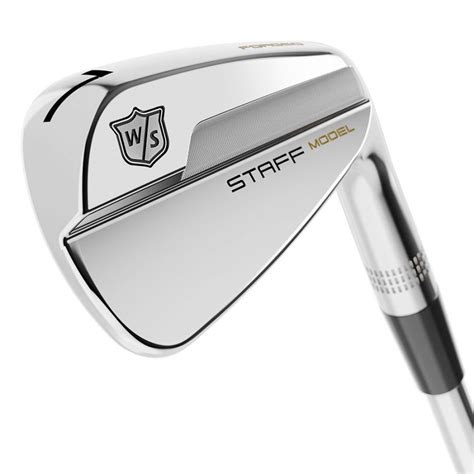What is Wilson Staff Model Blade Irons?
Wilson Staff Model Blade Irons are highly regarded among low to mid handicappers. These irons offer a classic, muscleback look and feel, with a premium look and stunning design that exudes quality. They are known for their tour-proven performance and are specifically designed to cater to better players demanding feel and feedback.
Manufactured with a 8620 carbon steel construction , Staff Model Blade Irons offer a highly polished mirror finish , putting them in a different category among other golf clubs. These irons offer players with a challenge that enhances their ability and forces them to concentrate more on the game.
Wilson has been producing and perfecting the Staff Model Blade Irons since 1954 , and they have proven to be a game-changer for many golfers. Their modern version of the classic blade iron has continued to attract a wide range of golfers, from beginners to professionals.
In conclusion, if you are a low to mid handicapper looking for a challenge and wish to improve your game, there is a high chance that you will enjoy using Wilson Staff Model Blade Irons. These irons offer premium features and a classic style that is both fashionable and functional.
Frequently Asked Questions about wilson staff model blade irons
Blade irons are best for experienced, consistent golfers
A blade iron is a traditional-style iron. Because the club is so short and compact, the center of gravity is near the shaft. So for a shot to land where you want it, you'll have to hit it in the center each time.
Okay. So this this over here where the hosel joins to the club. Head on a blade is often very flat. Almost square and on a cavity back majority of the time. It's going to enter.
Blades can be made from a variety of materials. The most common being carbon steel, stainless steel, tool steel and alloy steel. Other less common materials in blades include: cobalt and titanium alloys, ceramics, obsidian, and plastic. The hardness of steel is usually stated as a number on the Rockwell C scale (HRC).
Blades are manufactured of two common iron alloys: carbon steel and stainless steel. Carbon steel is manufactured from iron strengthened with carbon. Stainless steel also incorporates chromium to prevent corrosion. Carbon steel is used for blades that have to perform rugged tasks under severe conditions.
The "blade" refers to a golf club head with an offset, square top that gives you better ball flight through the air. It has a thinner face than other irons for increased ball speed and extra distance. It's the equipment seasoned players need to master their short game.
Cavity back irons launch the ball higher due to their low center of gravity and perimeter-weighted design. Whereas muscle backs and blades launch the ball lower – if all else stays the same. If you want the forgiveness of a cavity back, but want a lower launch, we have great news for you.
Blades can be made from a variety of materials. The most common being carbon steel, stainless steel, tool steel and alloy steel. Other less common materials in blades include: cobalt and titanium alloys, ceramics, obsidian, and plastic. The hardness of steel is usually stated as a number on the Rockwell C scale (HRC).
A blade is the portion of a tool, weapon, or machine with an edge that is designed to puncture, chop, slice or scrape surfaces or materials.
Blades can be made from a variety of materials. The most common being carbon steel, stainless steel, tool steel and alloy steel. Other less common materials in blades include: cobalt and titanium alloys, ceramics, obsidian, and plastic. The hardness of steel is usually stated as a number on the Rockwell C scale (HRC).
The “conventional” method is to put all the elements together with carbon and iron, heat them until they melt and are thoroughly mixed, and pour the mixture into molds to form massive ingots. The cooled mixture is called an alloy, and knife steel has been made this way for hundreds of years.
Blades vs cavity back irons
The main difference between blades and cavity back irons is the head design and overall look of the club, with the cavity back irons being larger and having more perimeter weighting. This design results in a lower center of gravity, higher ball flight, and more forgiveness.
Conclusion: If you're a consistent ball striker who can hit the ball in the center or center heel, blades will give you great performance with exceptional feel. If your miss, however, is more spread out with toe and heel misses, then stick with cavity-backs as they give you better overall distance loss across the face.
Cavity back irons are forgiving, have a thicker and bulkier sole, and have a more modern look than traditional blade-style golf irons. Golfers that play cavity back irons are typically looking for more of a game improvement style and need the extra forgiveness that these clubs provide.














